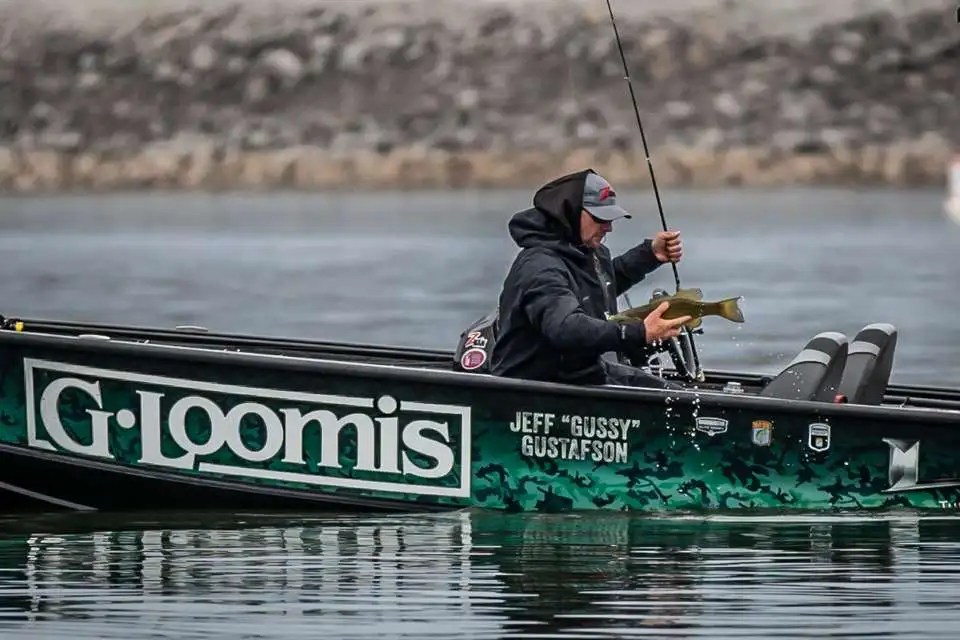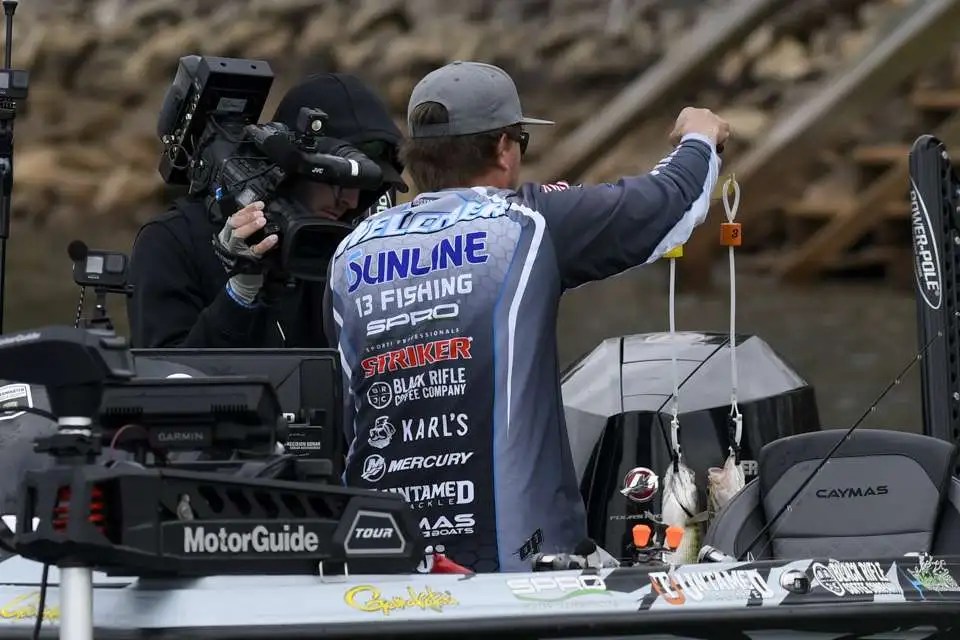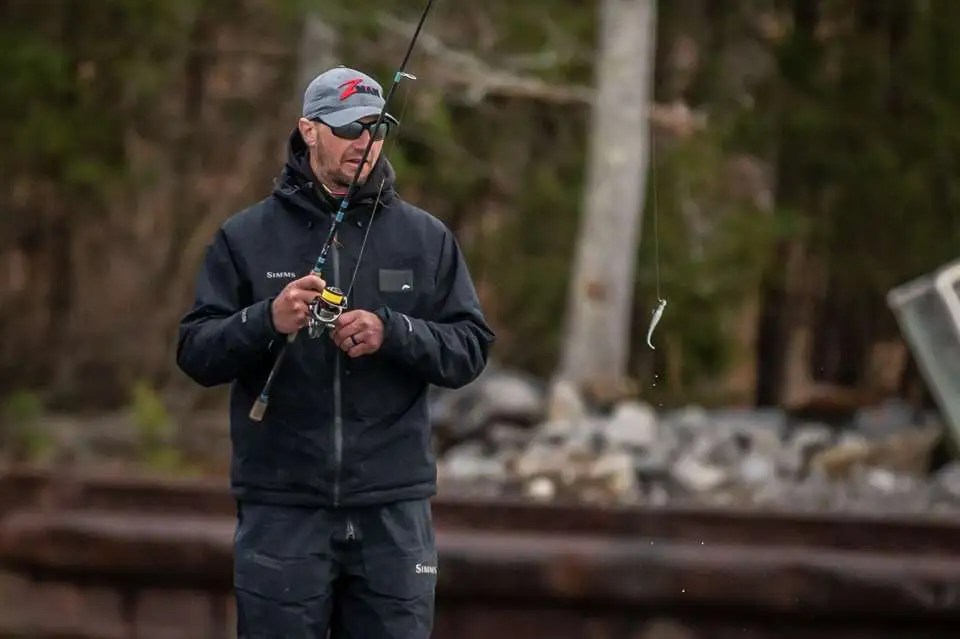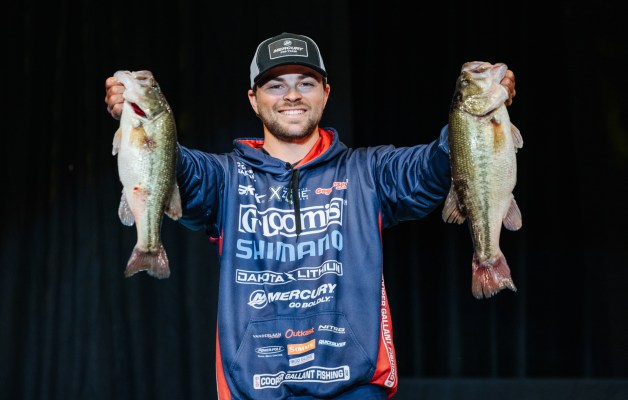
Of the 54 anglers qualified to fish the 2023 Academy Sports + Outdoors Bassmaster Classic presented by Toyota, few will be put on the spot more than Elite pro Jeff Gustafson. Having won his first Elite trophy at the 2021 Elite tournament on the same waters — Fort Loudoun and Tellico lakes — the man they call “Gussy” opened a lot of eyes by using one of his favorite northern techniques and by revealing just how many big smallmouth inhabit those waters.
Moping (aka Damiki rigging in southern waters) vertically presents a small jig and a minnow-style body to target suspended fish. Gustafson used this presentation over deep rocks near the U.S. Hwy. 321 Bridge that crosses the canal linking both lakes.
It might seem like an easy assumption that Gustafson would favor a repeat performance, but that may or may not be a viable option. Timing is the key component, as the Classic’s March 24-26 schedule falls about a month later in the year than the Elite that Gustafson won.
That was mostly a winter pattern, and while he’s not ruling out the possibility of returning to where it went down in 2021, Gustafson is keeping his options open.
“I’m going there to try and find where those smallmouth are,” Gustafson said. “I know (that smallmouth option) exists, but they might be in 4 feet of water this time, or they might be in 25 feet of water. I don’t know; that was the only time I’ve fished that place.”
Going for broke
The great thing about Classic competition is anglers don’t accrue otherwise valuable Bassmaster Angler of the Year points, encouraging more aggressive and rewarding strategies. Anglers willing to play the risk vs. reward game could find themselves with a life-changing conclusion.
“It’s exciting, because in that event, you can kind of go for broke,” Gustafson said. “Everybody says that, but I’m definitely going there to replicate what I did.
“I’m sure it will have to be in a new area and in some different spots, and who knows how you’re going to catch them. But I’m definitely going there to look for that (smallmouth bite).”
In the ideal scenario, Gustafson envisions finding more — or similar — places like those that produced his winning catches. Time was working against him at the 2021 Elite, so he’s eager to give the fishery a more thorough look.
“I found those fish, literally, the last couple hours of practice, so I didn’t really get to expand on them,” Gustafson said. “I tried to a little bit during the event, once I caught some fish, and never really found anything but what I had.”

Largemouth, smallmouth or both?
Predicting the exact mix of largemouth and smallmouth in the winning total is, at this point, a guessing game. Most would agree that green ones and brown ones will play roles in this year’s Classic, but weather, fishing pressure and, of course, angler decisions will create a dynamic process.
Traditionally, largemouth dominate spring tournaments on these waters, but with Gustafson’s win revealing how many smallmouth live there, anglers can’t afford to take that off the table. Numerically, the Classic field is likely to favor largemouth, however, Kyle Welcher, who finished a close second to Jason Christie at last year’s Classic on Lake Hartwell, takes a more resolute stance.
“In my opinion, when you fish (Loudoun and Tellico), you have to fish in an area where you can catch both — big smallmouth and big largemouth,” Welcher said. “They may, at some point, get on the same stuff and in March when they’re spawning, you can catch them on those shallow rocks, shallow docks and have a chance at an 18-inch smallmouth and a big largemouth.
“I think you’ll see somebody commit and try to fish for largemouth, and they’ll probably catch a big bag. But I don’t think they’ll be able to consistently catch that 15-pound (daily) mark. If you’re not mixing in some smallmouth, after two, I don’t think you’re going to be able to sustain the weight it’s going to take to win.”
Gustafson is confident with his ability to fish for prespawn largemouth, but he’s also savvy enough to know the majority of the Classic field shares this competency. In his view, he needs to leverage his smallmouth prowess to pull away.
“I’ll try and make it happen with smallmouth,” Gustafson said. “I’m not going to beat these guys just beating the bank, so I have to fish my strengths, and that’s going to be smallmouth fishing.
“You’ll probably need to mix in some largemouth here and there to fill your bags and maybe get a kicker. That’s going to be part of it, but my main agenda the first part of practice is going to be trying to locate some smallmouth.”
Patterns to look for
Noting that he’ll welcome big bites of either species, Welcher called site selection the essential strategy point.
“It’s definitely going to be about those prespawn places they’re moving to,” he said. “Somebody’s going to find an area that the fish are coming to every single day, and that’s going to be the person that wins the tournament.”
Brandon Lester, who finished sixth at the 2019 Classic held on Loudoun and Tellico, said the often-fickle spring weather patterns will determine much. A Classic week warmup will push a lot of fish into the creeks, whereas colder conditions will hold them on the main river.
Gustafson’s not married to one lake or the other — or the linking canal. His main objective will be finding the cleanest water.
Lester agrees and notes that one of the Tennessee River’s prominent features bears a dual impact in terms of clarity and habitat — freshwater mussels. Filtering incredible amounts of water daily, bivalves of multiple species are fairly well distributed throughout Classic water, so they will almost certainly give up some of the key fish.
“I can see them playing a role,” Lester said of the mussel bar pattern. “They’re always on hard-bottom areas where prespawn fish like to stage.
“A guy might roll up and catch one or two, unless you could find enough to make a pattern.”
Something to consider is the likelihood of bite windows occurring throughout the fishery, including those mussel bars. On the latter, Lester said a patient, flexible approach is the best way to maximize a sensitive scenario.
“Those shallow fish bust up a lot quicker than a school in 15 feet,” Lester said. “Once they (break apart), it takes them a while to get back together.”
Buddy Gross, who won the second 2022 Elite event at Florida’s Harris Chain, did so largely by working a shell bar in Lake Harris. Although a different vibe than a TVA lake, he points out a mussel detail that’ll also apply to Classic waters.
“The bite can last all day long, but you can wear the school out,” Gross said. “You just let them rest and then come back later.
“They may be off of one bar today, but back on it tomorrow. It’s not so much a graphing deal, you just have to fish them.”

Lures to watch for
Gustafson will keep his moping rig handy, but he also believes the jerkbait could prove productive, along with bottom finesse rigs. Welcher expects to see flipping jigs nabbing keepers on docks, rocks and shallow wood, but he’ll also have a handful of rods rigged with reaction baits.
“I think you’ll see vibrating jigs, swimbaits — large and small — and a lot of cranking,” Welcher said. “I think a crankbait will be a big player this time.”
Gross said shellbars accommodate a wide range of baits, including crankbaits, rattlebaits, Carolina rigs and football head jigs. A jerkbait could also play for the mussel game.
If Welcher could have one bait to tempt a big largemouth or a sizable smallmouth bass, what would it be?
“A flat-sided crankbait — that’s my opinion,” he firmly stated. “I just think that’s the most efficient way to fish that 3- to 6-foot rock depth where those prespawn largemouth and smallmouth are going to be staging.
“In prespawn, those fish don’t want something extremely (active) as far as the vibration, I think a flat-sided crankbait’s smaller profile and more subtle action is going to trigger the bigger fish.”





